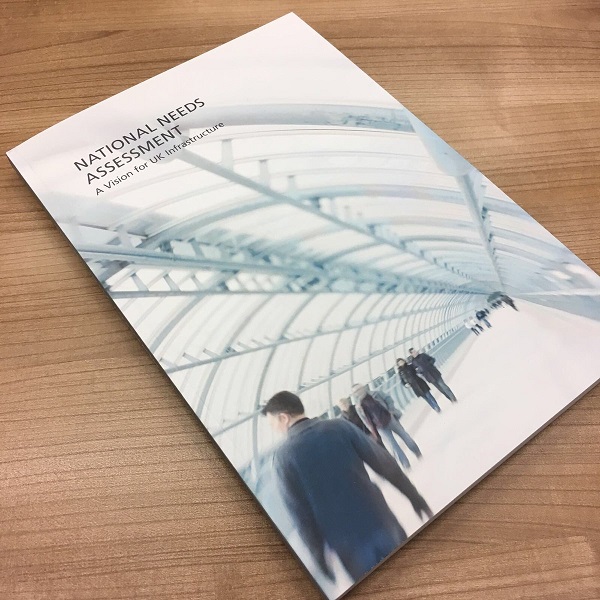National Needs Assessment NNA
On 19 October 2016, the National Needs Assessment (NNA) for UK infrastructure was launched following an assessment lasting 15 months in which a wide range of industry experts, investors, environmental, legal and professional bodies, and politicians were engaged.
It was written by Atkins, ICE and ITRC, and the project team included Atkins, ICE, ITRC, KPMG and Pinsent Masons.
The NNA, the first of its kind, outlines the changing demands on the UK’s infrastructure and discusses the steps necessary to create a national system that is ‘efficient, affordable and sustainable’, and delivers on needs until 2050. The report provides a blueprint for an assessment by the government-backed National Infrastructure Commission, due to be published in 2018.
The vision presented by the NNA is one of a nation with balanced economic growth, thriving communities and a low carbon future.
In order to create a stable environment for long-term investments, it suggests a diverse mix of electricity generation based on nuclear, renewables, gas and interconnectors, such as that set out by the Committee on Climate Change:
- 20-25% nuclear.
- 35-40% renewable.
- 25-30% Combined Cycle Gas Turbine.
- 10% interconnection.
A series of recommendations are made to develop infrastructure that will position the UK as an innovative global trading nation in the face of considerable challenges such as climate change and population growth.
Key findings from the report include:
- There is a need for a long-term strategic approach to infrastructure provision.
- The government must commit to stable policies for infrastructure which transcend political cycles, particularly for energy.
- Future infrastructure needs are intertwined, and this requires an integrated cross-sectoral approach.
- Infrastructure funding models need to evolve in line with technological innovation.
- New and retrofitted buildings should take advantage of the opportunities for innovation in terms of ultra-fast digital connectivity, smarter use of energy and storage, and reuse of rainwater and sewage.
- Innovation and training is the key to reducing the cost of building and operating infrastructure.
Sir John Armitt, Chair of the NNA and President of the Institution of Civil Engineers (ICE), said: "The country needs a clear strategy, management and establishment of critical standards for our infrastructure to sustain and improve quality of life and business competitiveness in a modern and evolving world. If we don't, we will lose out on many opportunities, particularly in a post-Brexit economy."
For more information and to download the NNA’s report, click here.
--The Institution of Civil Engineers
[edit] Related articles on Designing Buildings Wiki
- Articles by ICE on Designing Buildings Wiki.
- Brexit - The case for infrastructure.
- Construction 2025.
- Government Construction Strategy.
- Growth and Infrastructure Act.
- Infrastructure and Projects Authority.
- National Infrastructure Commission.
- National Infrastructure Plan.
- Overcoming the challenges of Brexit.
- Place infrastructure at the heart of economic policy.
Featured articles and news
A people-first approach to retrofit
Moving away from the destructive paradigm of fabric-first.
International Electrician Day, 10 June 2025
Celebrating the role of electrical engineers from André-Marie Amperè, today and for the future.
New guide for clients launched at Houses of Parliament
'There has never been a more important time for clients to step up and ...ask the right questions'
The impact of recycled slate tiles
Innovation across the decades.
EPC changes for existing buildings
Changes and their context as the new RdSAP methodology comes into use from 15 June.
Skills England publishes Sector skills needs assessments
Priority areas relating to the built environment highlighted and described in brief.
BSRIA HVAC Market Watch - May 2025 Edition
Heat Pump Market Outlook: Policy, Performance & Refrigerant Trends for 2025–2028.
Committing to EDI in construction with CIOB
Built Environment professional bodies deepen commitment to EDI with two new signatories: CIAT and CICES.
Government Grenfell progress report at a glance
Line by line recomendation overview, with links to more details.
An engaging and lively review of his professional life.
Sustainable heating for listed buildings
A problem that needs to be approached intelligently.
50th Golden anniversary ECA Edmundson apprentice award
Deadline for entries has been extended to Friday 27 June, so don't miss out!
CIAT at the London Festival of Architecture
Designing for Everyone: Breaking Barriers in Inclusive Architecture.
Mixed reactions to apprenticeship and skills reform 2025
A 'welcome shift' for some and a 'backwards step' for others.






















